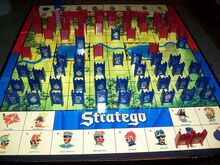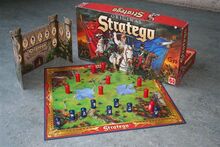Overview[]
Stratego is a strategy board game for two players on a board of 10×10 squares. Each player controls 40 pieces representing individual soldier ranks in an army. The objective of the game is to find and capture the opponent's Flag, or to capture so many enemy pieces that the opponent cannot make any further moves. Players cannot see the ranks of one another's pieces, so disinformation and discovery are important facets to gameplay.
History[]
Chinese predecessors[]
The origins of Stratego can be traced back to traditional Chinese board game "Jungle" also known as "Game of the Fighting Animals" (Dou Shou Qi) or "Animal Chess". The game Jungle also has pieces (but of animals rather than soldiers) with different ranks and pieces with higher rank capture the pieces with lower rank. The board, with two lakes in the middle, is also remarkably similar to that in Stratego. The major differences between the two games is that in Jungle, the pieces are not hidden from the opponent, and the initial setup is fixed.
A modern, more elaborate, Chinese game known as Land Battle Chess (Lu Zhan Qi) or Army Chess (Lu Zhan Jun Qi) is a descendant of Jungle, and a cousin of Stratego: the initial setup is not fixed, both players keep their pieces hidden from their opponent, and the objective is to capture the enemy's flag. Lu Zhan Jun Qi's basic gameplay is similar, though differences include "missile" pieces and a Chinese Chess-style board layout with the addition of railroads and defensive "camps". A third player is also typically used as a neutral referee to decide battles between pieces without revealing their identities. An expanded version of the Land Battle Chess game also exists, adding naval and aircraft pieces and is known as Sea-Land-Air Battle Chess (Hai Lu Kong Zhan Qi).

European predecessors[]
In its present form Stratego appeared in Europe before World War I as a game called L'attaque. Thierry Depaulis notes that the 1910 version divided the armies into red and blue colors. The rules of L'attaque were basically the same as the game we know as Stratego. It featured standing cardboard rectangular pieces, color printed with soldiers who wore contemporary (to 1900) uniforms, not Napoleonic uniforms.
Classic Stratego[]
The modern game of Stratego, with its Napoleonic imagery, was originally manufactured in the Netherlands by Jumbo. Pieces were originally made of printed cardboard. After World War II, paintedwood pieces became standard. The game was licensed by the Milton Bradley Company for American distribution, and introduced in the United States in 1961 (although it was trademarked in 1960).
Starting in the late 1960s all versions switched to plastic pieces. The change from wood to plastic was made for economical reasons, as was the case with many products during that period, but with Stratego the change also served a structural function: Unlike the wooden pieces, the plastic pieces were designed with a small base. The wooden pieces had none, often resulting in pieces tipping over. This, of course, was disastrous for that player, since it often immediately revealed the piece's rank, as well as unleashing a literal domino effect by having a falling piece knock over other pieces. European versions introduced cylindrical castle-shaped pieces that proved to be popular. American variants later introduced new rectangular pieces with a more stable base and colorful stickers, not images directly imprinted on the plastic.
The game is particularly popular in the Netherlands, Germany, and Belgium, where regular world and national championships are organized. The international Stratego scene has, more recently, been dominated by players from the Netherlands.
European versions of the game give the Marshal the highest number (10), while the initial American versions give the Marshal the lowest number (1) to show the highest value (i.e. it is the #1 or most powerful tile). More recent American versions of the game, which adopted the European system, caused considerable complaint among American players who grew up in the 1960s and 1970s. This may have been a factor in the release of a Nostalgic edition, in a wooden box, reproducing the Classic edition of the early 1970s.
Modern Stratego variations[]
The Jumbo Company continues to release European editions, including a three- and four-player version, and a new Cannon piece (which jumps two squares to capture any piece, but loses to any attack against it). It also included some alternate rules such as Barrage (a quicker two-player game with fewer pieces) and Reserves (reinforcements in the three- and four-player games). The four-player version appeared in America in the 1990s.

Electronic Stratego was introduced by Milton Bradley in 1982. It has features that make many aspects of the game strikingly different from those of classic Stratego. Each type of playing piece in Electronic Stratego has a unique series of bumps on its bottom that are read by the game's battery-operated touch-sensitive "board". When attacking another piece a player hits their Strike button, presses their piece and then the targeted piece: the game either rewards a successful attack or punishes a failed strike with an appropriate bit of music. In this way the players never know for certain the rank of the piece that wins the attack, only whether the attack wins, fails, or ties (similar to the role of the referee in the Chinese game of Luzhanqi). Instead of choosing to move a piece, a player can opt to "probe" an opposing piece by hitting the Probe button and pressing down on the enemy piece: the game then beeps out a rough approximation of the strength of that piece. There are no bomb pieces: bombs are set using pegs placed on a touch-sensitive "peg board" that is closed from view prior to the start of the game. Hence, it is possible for a player to have their piece occupying a square with a bomb on it. If an opposing piece lands on the seemingly-empty square, the game plays the sound of an explosion and that piece is removed from play. As in classic Stratego, only a Miner can remove a bomb from play. A player who successfully captures the opposing Flag is rewarded with a triumphant bit of music from the 1812 Overture.
How to Play[]
Stratego is a game in which you need to capture the flag of your opponent while defending your own flag. To capture the flag you use your army of 40 pieces. Pieces have a rank and represent individual officers and soldiers in an army. In addition to those ranked pieces you can use bombs to protect your flag.
Pieces move 1 square per turn, horizontally or vertically. Only the scout can move over multiple empty squares per turn. Pieces cannot jump over another piece.

If a piece is moved onto a square occupied by an opposing piece, their identities are revealed. The weaker piece is removed from the board, and the stronger piece is moved into the place formerly occupied by the weaker piece. If the engaging pieces are of equal rank, they are both removed. Pieces may not move onto a square already occupied by another piece without attacking. Exception to the rule of the higher rank winning is the spy. When the spy attacks the marshal, the spy defeats the higher ranked marshal. However, when the marshal attacks the spy, the spy loses. Bombs lose when they are defused by a miner.
The bombs and the flag cannot be moved. A bomb defeats every piece that tries to attack it, except the miner. The flag loses from every other piece. When you capture the flag of your opponent you win the game.
The Stratego board consists of 10 x 10 squares. Within the board there are two obstacles of 2 x 2 squares each. Pieces are not allowed to move there.
The following pieces are used in Stratego (ranked from low to high):
- Flag (1x)
- Bomb (6x)
- Spy (1x)
- Scout (8x)
- Miner (5x)
- Sergeant (4x)
- Lieutenant (4x)
- Captain (4x)
- Major (3x)
- Colonel (2x)
- General (1x)
- Marshall (1x)
In addition to the Stratego version played with 40 pieces there are also a 20-piece version and a 10-piece version. In these versions the usual Stratego board of 10 x 10 squares is used with fewer pieces. The traditional Stratego rules also apply here.
Revisions and Expansions[]
Release versions[]
Official Modern Version: Also known as Stratego Original. Redesigned pieces and game art. The pieces now use stickers attached to new "castle-like" plastic pieces. The stickers must be applied by the player after purchase, though the box does not mention any assembly being required. Ranking order is reversed to adopt European play style (higher numbers equals higher rank).
Science Fiction Version: Jumbo / Spin Master version of Stratego, Common in North America department stores. The game has a futuristic science fiction theme. Played on a smaller 8x10 board, with 30 pieces per player. Unique spotter unit is one of the pieces.
Nostalgia Game Series Edition: Traditional stamped plastic pieces, although the metallic paint is dull and less reflective than some older versions, and the pieces are not engraved as some previous editions were. Wooden box, traditional board and game art.
Library Edition: Hasbro's Library Series puts what appears to be the classic Stratego of the Nostalgia Edition into a compact, book-like design. The box approximates the size of a book and is made to fit in a bookcase in one's library. In this version, the scout may not move and strike in the same turn.
Stratego Onyx: Stratego Onyx is sold exclusively by Barnes & Noble. It includes foil stamped wooden game pieces and a raised gameboard with a decorative wooden frame.
Franklin Mint Civil War Collector's Edition: The Franklin Mint created a luxury version of Stratego with a Civil War theme and gold- and silver-plated pieces. Due to a last-minute licensing problem, the set was never officially released and offered for sale. The only remaining copies are those sent to the company's retail stores for display.
Ultimate Stratego: No longer in production, this version can still be found at some online stores and specialty gaming stores. This version is a variant of traditional Stratego and can accommodate up to 4 players simultaneously. The Ultimate Stratego board game contained four different Stratego versions: "Ultimate Lightning", "Alliance Campaign", "Alliance Lightning" and "Ultimate Campaign".
Stratego CD-ROM: No longer in production, this version can still be found in many online stores. Produced by Hasbro Interactive this game combined Classic and Ultimate Stratego to give a choice of five different versions.
Stratego Waterloo: For the bicentenary of the Battle of Waterloo in June 2015, the Dutch publishing group Jumbo published Stratego Waterloo. Instead of using ranks, the different historical units that had actually fought at the battle were added as pawns (Old Guard, 95th Rifles...) - each with their own strengths and weaknesses. The pawns are divided into light infantry, line infantry, light cavalry, heavy cavalry, artillery, commanders and commanders in chief (Wellington and Napoleon). Instead of capturing the flag, the players must get two of their pawns on the lines of communication of their opponent.
Promotional[]
Hertog Jan, a Dutch brand of beer, released a promotional version of Stratego with variant rules. It includes substantially fewer pieces, including only one Bomb and no Miners. Since each side has only about 18 pieces, the pieces are far more mobile. The scout in this version is allowed to move three squares in any combination of directions (including L-shapes) and there is a new piece called the archer, which is defeated by anything, but can defeat any piece other than the Bomb by shooting it from a two-square distance, in direct orthogonal, or straight, directions only. If one player is unable to move any more of his pieces, the game results in a tie because neither player's flag was captured.
Commercial[]
These variants are produced by the company with pop culture themed pieces.
- The Lord of the Rings
- Star Wars
- Chronicles of Narnia
- Pirates of the Caribbean
- Marvel Comics (2007)
- Transformers (2007)
- Sharpe's Attack
- Duel Masters
Produced by Avalon Hill:
- Stratego: Legends (1999)
Produced by USAopoly:
- Civil War Stratego (2007)

